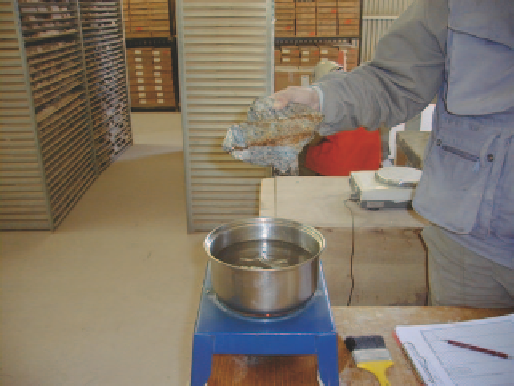Geoscience Reference
In-Depth Information
Table 5.1
Example of the
impact extreme assay values in
terms of quantity of metal (QM)
for a gold deposit
$X
&XWRII
JW
7RWDO''+
0HWHUV
*UDGHDERYH
FXWRIIJW
0HWDODERYH
FXWRIIPJW
40DERYH
FXWRII
7RWDO
0HWHUV
advisable to obtain dry density measurements, a commonly
used procedure involves:
1. Carefully weigh the sample as it was received from the
field.
2. Completely dry the sample on a conventional oven at
(typically) 105 °C, and weigh again. The difference be-
tween the two weights provides an estimate of moisture
content in the rock.
3. Submerge the sample in water (density 1.0 g/cm
3
) and re-
cord its weight.
4. Apply Eq. 5.2 above to determine the rock density.
The impact of water absorption by the sample is a function
of how porous the rock is, but it will always increase the
density value, since water is replacing air within the speci-
men. To avoid measurement errors derived from the water
absorbed by the rock during immersion, a more robust alter-
native for density measurements is to coat the sample with a
wax of known density to seal the internal voids in the rock.
Figure
5.19
shows a photograph of the waxing step, bulk
density determination using the wax-coating method.
The density determination now is a function of the dry
and wet coated weights, dry uncoated weight, and the known
wax density:
Fig. 5.19
Wax-coating density determination method, waxing step.
Courtesy of BHP Billiton, Chile
host rock. If there is a sufficiently high concentration of met-
als (grade), then the density of the rock will be influenced by
its metal content. Typical examples of deposits where there
is usually a clear correlation between grade and density are
uranium deposits, massive sulfides, iron deposits, and some
high grade gold deposits.
Certain geologic factors will also have an impact on the
expected density. For example, in an open pit mine, barren
material that must be removed to access the deposit may
be lighter than consolidated rock (bedrock), since it may
consist of gravels or loose highly weathered material. Cer-
tain types of host rocks are porous such as breccias with
significant voids, which despite being favorable hosts for
mineralization and having generally good grade, will tend
to be lighter. The type and intensity of alteration will also
affect the in situ density values. Highly altered rock is fri-
able, powdery in extreme cases, and generally lighter than
unaltered rock.
It is usually convenient to define density domains based
on a combination of lithology, alteration, mineralogy, and
average grades of the rock. There should be an adequate
†
‡
ˆ
‰
W
ˆ
‰
Density
=
ˆ
air
‰
WW
−
(
WW
−
)
−
Cair
air
ˆ
‰
Cair
Cwater
δ
Š
‹
wax
where W
air
is the dry weight in air, prior to wax coating;
W
Cair
is the dry weight of the coated sample; W
Cwater
is the
weight of the coated sample in water, and
δ
wax
is the known
density of the wax.
The spatial distribution of density measurements is also
an important consideration. The density samples obtained
must be representative in a spatial and geologic sense.
Sample density may be correlated to sample grade. This is
because most metals have a higher specific gravity than the





















